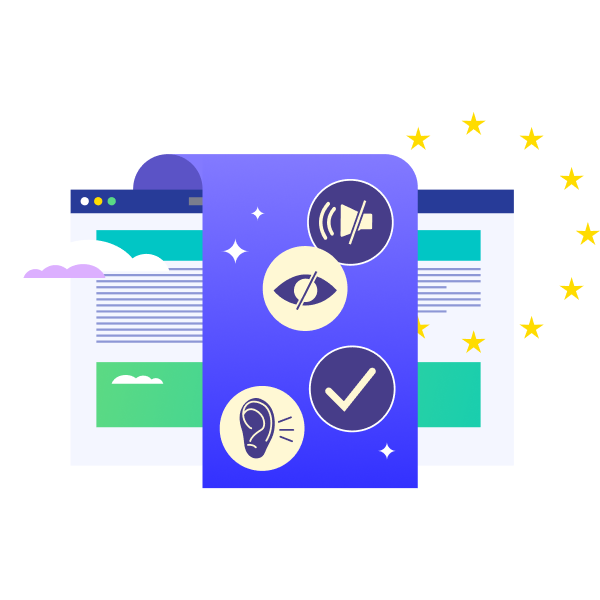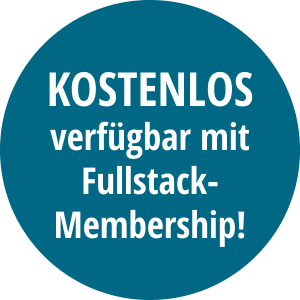Web Accessibility: From Compliance to Strategic Advantage
- 9 Teile & über 7 Std. Lerninhalte
- Für Einsteiger und Fortgeschrittene
-
Sprache: Englisch

Barrierefreiheit wird Pflicht!
Mit dem Barrierefreiheitsstärkungsgesetz (BFSG) und dem European Accessibility Act (EAA) treten ab dem 28. Juni 2025 neue gesetzliche Anforderungen in Kraft. Digitale Produkte und Services müssen dann für alle Menschen zugänglich sein – unabhängig von körperlichen oder kognitiven Einschränkungen. Unser Kurs zeigt dir, wie du diese Vorgaben nicht nur einhältst, sondern digitale Erlebnisse entwickelst, die wirklich inklusiv sind – über Websites, Apps, Medien und Marketing hinweg.
Dein Vorteil durch barrierefreies Design
Barrierefreiheit lohnt sich: Schneller ladende Seiten, bessere Sichtbarkeit bei Google, geringere Wartungskosten und zufriedene Nutzer auf allen Geräten. Du lernst praxisnah, wie du manuelle und KI-gestützte Tests einsetzt, intuitive Benutzeroberflächen gestaltest und Barrierefreiheit strategisch in deinen Arbeitsalltag integrierst – mit echten Mehrwerten für Unternehmen und Nutzer.
Das erwartet dich
- 6 Sessionaufzeichnungen der Webinale Berlin
- 2 Artikel unserer bekannten Magazinbrand
- 1 exklusives Fullstack Live-Event
6 Sessions der Webinale Berlin | 5 Std. 30 Min.
Automated & Manual Testing + AI – A Holistic Approach to Accessibility | Abhay Kapur
In the quest for truly inclusive digital experiences, accessibility testing can’t be an afterthought. This session explores a holistic approach that combines the strengths of automated testing, manual evaluation, and emerging AI technologies to build websites and applications that truly work for all users.
We will dive into how automated tools can detect common issues, how manual testing uncovers the real-world challenges users face, and how AI can help increase efficiency by detecting context and patterns.
Whether you’re a developer, tester, designer, or product owner, this session will equip you with practical insights to create more inclusive digital products – because accessibility isn’t just a legal requirement, it’s our shared responsibility.
Accessible Watch Experience: How WDR is Using AI to Shape the Future of Media for People With Hearing Disabilities | Christian Klöckner & Hannes Hölzl
How can artificial intelligence (AI) improve the accessibility of media content and promote participation for people with hearing impairments? Moving image content poses a major challenge, as subtitles often have to be created by speaking – especially for live formats, this is time-consuming and often inadequate. Can AI offer an efficient and user-friendly solution to optimize this process? WDR investigated these questions as part of the development of AI-based subtitling for the German television program WDR Lokalzeit. In order to test both the technological and functional aspects, the prototype underwent user testing. The UX/UI team at Appmatics planned and managed this accessibility test. The aim of the exploratory approach was to investigate how people with different degrees of hearing impairment perceive and evaluate the AI-generated subtitles. Project manager Hannes shares insights from the testing process and shows how AI and user-centred design interact in the testing process. He also gives an outlook on the future of accessible, AI-supported media offerings and their potential for widespread use in digital media.
Accessibility Between Human Feedback and AI Feedback: User-Centered Design For Everyone | Laura Marwede
Artificial Intelligence (AI) offers significant potential for improving accessibility by automating processes such as user feedback and language simplification. However, our real-world case studies reveal that relying only on AI-generated solutions often falls short, particularly when addressing nuanced challenges like simplified language and accessible design for diverse user groups. This talk explores the intersection of AI and human feedback in UX design, highlighting the essential role of direct input from affected individuals to complement AI-driven approaches. Through practical examples, we will demonstrate how AI tools can enhance efficiency while maintaining the critical need for empathetic, user-centred validation. By integrating AI capabilities with participatory design practices, we can create more inclusive, effective solutions. Attendees will gain insights into best practices for leveraging AI without compromising the human element, fostering genuinely accessible digital experiences. This session advocates for a balanced approach: combining AI efficiency with the irreplaceable depth of human feedback of those who are in need of accessible software, to ensure technology serves all users equitably.
Digital Accessibility: From Hidden Pitfalls to Lasting Solutions | Nina Jameson
Truly accessible experiences aren’t born from simply checking off boxes — they blossom when every step is crafted with inclusivity at its core. In this session, we’ll shine a light on both everyday and subtle barriers that can quietly hinder users, helping you spot and address them before they become showstoppers. Next, you’ll discover how semantic HTML, a thoughtful approach to ARIA, and smart design principles can work together to build robust, user-friendly components. Finally, we’ll explore the possibilities (and limitations) of automated and manual testing, ensuring accessibility remains a guiding force throughout your development process. Come away with practical methods to unite your team around shared standards and create a product that truly includes and inspires every user.
Accessible Marketing as a Strategic Framework | Norman Bielig
Accessible marketing can do more than facilitate people’s access to information, communication and participation. For brands, it can serve as a strategic framework for making clearer decisions and escaping from self-made communicative rabbit holes. Dealing with accessibility always creates an awareness of exclusivity and inclusivity – and thus the prerequisite for strategic decisions with a clear business impact.
Approach With Care – Making Digital Accessibility Feel Natural | Daniel Yuschick
Our lives are increasingly lived online. Think about it — we work, study and socialize online. We talk with our therapists and consult with doctors online. We bank, shop and pay taxes online. Digital accessibility has never been more important than it is right now. Despite this, making our work accessible can feel like an overwhelming mystery.
This talk will teach us how to greatly impact the accessibility of our work with various approaches to our design and development tasks. We will identify many common UI (User Interface) patterns, and learn how to approach them in order for assistive technologies, such as screen readers, to understand and communicate them clearly. We will highlight and reiterate how accessible design is good design and benefits everybody. All of this without looking at a single line of code.
The goal of this talk is to reframe how we think about and start our design and development work to make accessibility feel like a natural part of our workflow. We are not building software for users, but for people — and all people deserve empathy from the digital products that make up their very real lives.
2 Artikel aus unseren bekannten Magazinen | 40 Min.
Designing for Accessibility: EU Compliance Made Simple | Alexandra Paschal
Simple Steps for Better Web Accessibility | Maria Korneeva
1 Fullstack Live-Event | 90 Min.
Digital Accessibility: From Obligation to Opportunity | Nina Jameson, Frank Puscher
By June, accessibility will become a legal requirement for businesses across the EU. With nearly 8 million people in Germany living with a severe disability, digital inclusivity is no longer optional—it’s essential. But how can businesses, designers, and developers implement accessibility effectively? What does the Accessibility Act actually require?
In this talk, multiple keynotes, short talks, and discussions will provide practical insights into accessibility in web design, development, digital marketing, and UX. Experts will share how different disciplines can collaborate to create truly inclusive digital experiences.
What to expect:
- From Law to Practice: Understanding the key requirements of the Accessibility Act
- Inclusive Design in Action: Best practices for implementing accessibility in web projects
- Testing & Optimization: How to assess and improve accessibility in digital products
- Business Impact: How accessible design can expand your customer base and boost engagement
- Seamless Integration: Making accessibility a natural part of your agency’s workflow
Discover how accessibility is more than just compliance—it’s a competitive advantage that benefits both businesses and users.
Expertenwissen für....
- UX/UI-Designer:innen, die intuitive und inklusive Nutzererlebnisse gestalten möchten.
- Webentwickler:innen, die digitale Produkte technisch barrierefrei umsetzen wollen.
- Product Owner & Projektmanager:innen, die gesetzliche Vorgaben einhalten und Barrierefreiheit strategisch planen müssen.
- Marketing- und Content-Teams, die barrierefreie Kommunikation in Websites, Kampagnen und Medieninhalten sicherstellen wollen.

Nimm teil und erfahre...
- Was BFSG und EAA bedeuten – welche Anforderungen ab 2025 erfüllt werden müssen.
- Wie du barrierefreie Produkte entwickelst – von der Konzeption über Design und Code bis zur Inhaltsgestaltung.
- Wie du manuell und mit KI testest, um Barrieren frühzeitig zu erkennen und zu beheben.
- Wie du barrierefreie Nutzererlebnisse gestaltest, die für alle Menschen funktionieren, unabhängig von Einschränkungen.
- Wie Barrierefreiheit zum Wettbewerbsvorteil wird durch bessere Usability, SEO, Performance und Nutzerbindung.
- Wie du Barrierefreiheit im Team und Unternehmen verankerst – mit Prozessen, Tools und Best Practices.

Unsere Experten und Speaker
Alexandra Paschal
Honeywell
UX Designer spezialisiert in Web Accessibility und Expertin für AI gestützte UX und Prdouktdesign

Dr. Maria Korneeva
Aleri Solutions GmbH
Frontend Technology Lead und Google Developer Expert mit Fokus auf Angular und Barrierefreiheit
Nina Jameson
Gehirngerecht Digital
Mitgründerin von Gehirngerecht Digital und Advokatin von inklusiven Digitallösungen
Frank Puscher
Freier Journalist
Journalist, Moderator and kritischer Beobachter der Digitalszene
Abhay Kapur
BarrierBreak
Produkmanager und Experte für Digital
Christian Klöckner
WDR und EBU
Technologie und Innovatons Ingenieur beim WDR Co-Chair TV Platform Group bei EBU
Hannes Hölzl
Appmatics GmbH
UX Researcher und UX Constultant
Laura Marwede
TEAM23 GmbH
Head of UX & Strategy at TEAM23, Expertin in UX Strategien, Agile Projekt Management und User-zentrierten Digitalprodukten
Norman Bielig
desire lines
Führender Experte und Stratege in Mobility-Innovation
Daniel Yuschick
Posti
Accessibility Advocate, Autor und Mentor
Mach den nächsten Schritt
mit der Fullstack Membership!
- Limitierter 30-Jahre Anniversary Hoodie
- Ticket für den entwickler Summit 2026
- Wöchentlich interaktive Live-Events
- Neueste Kurse zu Software und AI-Themen
- Jede Woche eine neue Tutorial-Lektion
- Zugriff auf +12 000 Artikel und Magazinarchiv
- 6 Monate Zugriff auf deine Konferenzsession
- 3 Monate Zugriff auf Live-Event Aufzeichnungen
- 50 Anfragen an entwickler intelligence im Monat
- Rabatte auf Konferenz und Trainings-Events
Teams mit 3-15 Nutzern
ab 116,60 € im Jahr*
*Preis pro Nutzer zzgl. MwSt.
Jetzt Fullstack Member werden & teilnehmen
Du bist bereits ein Fullstack Member? Dann logge dich auf entwickler.de ein und starte den Kurs. Zum Kurs

